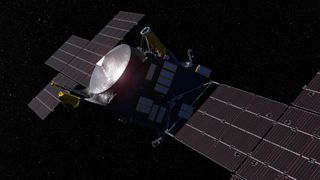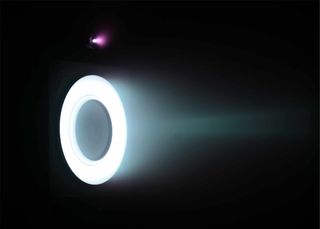
An artist’s impression of the Psyche spacecraft. The ‘wings’ are solar arrays that generate electricity from sunlight.
(Image credit: NASA/JPL–Caltech/ASU)
NASA’s mission to the metal-rich asteroid 16 Psyche has fired up its ion engines and is now cruising across the solar system under the power of solar-electric propulsion.
The launch of the spacecraft, which is also called Psyche, on October 13, 2023 gave it enough of an initial boost to take it across more than 190 million miles (300 million kilometers) of space, which is beyond the orbit of Mars.
Now, however, its onboard ion engines have taken over the job of acceleration. They work by converting sunlight into electricity via the spacecraft’s solar arrays that form its “wings.” The resulting electrical current powers an electromagnetic field that accelerates and expels ions, which are charged particles, of xenon gas. As the ions are accelerated out of the four thrusters, creating an eerie blue glow, they impart a momentum upon the spacecraft, pushing it in the opposite direction.
Related: Laser on NASA’s Psyche asteroid probe beams data from 140 million miles away
The force exerted by expelled ions is small; each thruster provides a pressure equivalent to three coins pressing into your hand due to the force of gravity. However, with no atmospheric friction in space, this gentle thrust can build up, quickly accumulating to accelerate the spacecraft at higher and higher rates. Psyche is currently racing through space at 84,000 miles (135,000 kilometers) per hour, and the intention is to get it up to 124,000 miles (200,000 kilometers) per hour.
The spacecraft’s ion engines are currently firing almost constantly and taking it forward, but as part of Psyche’s journey to its eponymous asteroid, it will loop back around and encounter Mars in May 2026. On approaching the Red Planet, Psyche will shut down its ion engines and allow itself to get caught in Martian gravity and be slingshot around the planet.

An Aerojet Hall thruster is shown in operation. (Image credit: Aerojet)
After this gravity assist, the ion engines will power back up and the spacecraft’s next stop will be the asteroid 16 Psyche in 2029, which it will orbit for at least two years. The asteroid 16 Psyche is of interest to scientists because it is a large, 173-mile-wide (280-kilometer-wide) fragment of an ancient planet’s metallic core that was left over from our solar system’s period of planet formation, about 4.5 billion years ago. By learning about 16 Psyche, planetary scientists hope to discover more about the interiors of rocky planets like Earth, as well as how these worlds formed.
Breaking space news, the latest updates on rocket launches, skywatching events and more!
Throughout its journey, the spacecraft Psyche has not been idle. It has spent its time using various instruments to gather scientific data. For example, its magnetometer as well as its gamma-ray and neutron spectrometer have detected charged particles emitted by coronal mass ejections from the sun. Meanwhile, the spacecraft is also testing a new deep-space optical communications technology based on using lasers, rather than radio, to transmit data over interplanetary distances. A test of the system in April exceeded expectations by beaming back data at 267 megabits per second from a distance of 226 million kilometers (140 million miles). This bit rate is comparable to broadband download speeds in your home.
“Until this point, we have been powering on and checking out the various pieces of equipment needed to complete the mission, and we can report they are working beautifully,” said Henry Stone, who is the Psyche project manager at NASA’s Jet Propulsion Laboratory, in a statement.
Psyche isn’t the first mission to the asteroid belt to employ ion engines. Before it, NASA’s Dawn mission visited both Ceres and Vesta under the throttle of solar-electric propulsion. In Star Wars, the name of the Empire’s TIE fighters stands for Twin Ion Engine, but as Dawn, and now Psyche, demonstrate, such technology is no longer science fiction.
Join our Space Forums to keep talking space on the latest missions, night sky and more! And if you have a news tip, correction or comment, let us know at: [email protected].
Keith Cooper is a freelance science journalist and editor in the United Kingdom, and has a degree in physics and astrophysics from the University of Manchester. He’s the author of “The Contact Paradox: Challenging Our Assumptions in the Search for Extraterrestrial Intelligence” (Bloomsbury Sigma, 2020) and has written articles on astronomy, space, physics and astrobiology for a multitude of magazines and websites.
>>> Read full article>>>
Copyright for syndicated content belongs to the linked Source : Space.com – https://www.space.com/psyche-asteroid-mission-engine-fire-ion-cruise-control































